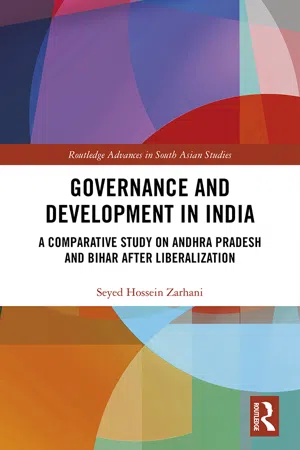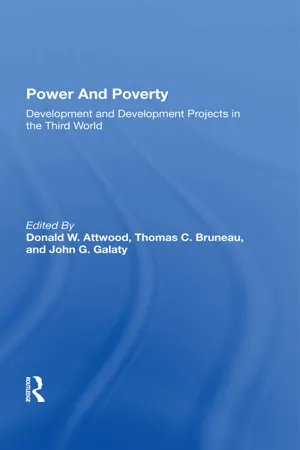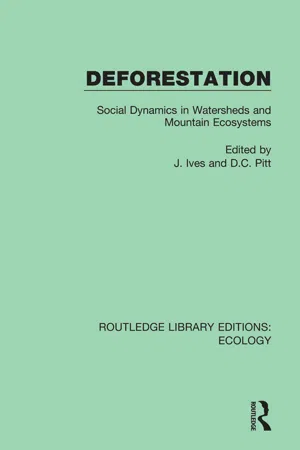Geography
Development of India
India's development has been shaped by its diverse geography, including the Himalayas, fertile plains, and coastal regions. The country's economic growth has been influenced by its agricultural, industrial, and service sectors, with rapid urbanization and infrastructure development playing key roles. India's development is also impacted by environmental challenges such as water scarcity and pollution.
Written by Perlego with AI-assistance
5 Key excerpts on "Development of India"
Learn about this page
Index pages curate the most relevant extracts from our library of academic textbooks. They’ve been created using an in-house natural language model (NLM), each adding context and meaning to key research topics.
- eBook - ePub
Corridor Development in India
Impact on Land Acquisition
- Vinita Yadav, Rohini Neelkanthrao Kalambe(Authors)
- 2022(Publication Date)
- Routledge India(Publisher)
Corridor development helps the region to strengthen their economic activities by creating job opportunities, reducing travel time involved in the export and import of materials, and providing infrastructure to particular regions. The establishment of economic development activities in the region helps to reduce urban rural migration and the unemployment ratio to a certain extent. Social development helps citizens to be aware of their rights and to understand new policies and technologies. India lags behind in this aspect of development as diversity and kinship behavior have a negative impact on developmental results. In India, for a long time, poverty alleviation has been an area of special emphasis for policy makers, as a result of which there does seem to have been a noticeable improvement in education and health as well as income standards post-independence. Yet, regardless of all of this, India happens to still rank among the 30 poorest nations of the world. This is despite the fact that the percentage of the total population under the poverty line declined from 55 percent in the 1970s to about 36 percent in the 1990s. Today, more than 50 percent of children under the age of four remain malnourished, while more than 30,000,000 are still below the poverty line. Despite the literacy levels having tripled as compared to 1951 figures, about 50 percent of the population remains illiterate, while more than 45 percent of all children do not even reach the fifth grade. These figures clearly show that there is a large scope to reduce the poverty numbers and at the same time also improve living conditions (Agrawal, 2000).In the earlier chapter, the process of displacement due to land acquisition and its socio- economic cultural consequences were reflected upon. Development implies the development of society as a whole and includes economic and political systems, the nature of social institutions, the structure of social relations, cultural patterns, and the nature of value and coordination as objectives of human life within a society. Economic development is deemed essential for the progress and prosperity of a country. Without development, the nation cannot grow or progress. This chapter gives insight to the processes adopted by families to utilize their compensation. There are flaws in the compensation utilization related process. The government’s effective efforts to improve people’s quality of life in marginalized and backward areas. At times, the compensation money is ineffectively and improperly utilized, causing problems such as poverty, malnutrition in children and women, and domestic violence. - eBook - ePub
Governance and Development in India
A Comparative Study on Andhra Pradesh and Bihar after Liberalization
- Seyed Hossein Zarhani(Author)
- 2018(Publication Date)
- Routledge(Publisher)
unified actor, which either succeeds or fails but does so coherently.” Most of the debates on the necessity of the state’s intervention in the economy, the impact of state’s institution on development, regime type and growth, and weakness and strength of the state are almost based on this unitary and the top-down notion of the state. These studies usually consider the Center, ruling party, and elites are the primary sources for reference. These approaches look at Jawaharlal Nehru, Indira Gandhi, Rajiv Gandhi, Narasimha Rao, Vajpayee, Manmohan Singh or Modi, as the key players in politics of development; therefore, their ideas, attitudes, and decisions are the crucial determinant of development or under development. Most of the literature on the relations between the state and economy in India concentrate predominantly on nature or policies of the Center or the role of leadership in Delhi. Can this image of the state provide us an appropriate and useful theoretical framework to analyze politics of development in India after the liberalization?Although these studies improve our understanding of the role of the Center in politics of development, the most significant problem is looking at India’s state as a unified and singular entity. India’s Constitution safeguarded the unity as well as diversity. Although the Center has a significant role in the Constitution, the subnational states have a significant role in policymaking and implementation of them. The Constitution, through forming an unusual federal design, balances the national interests in one hand and local and regional interests on the other hand. The interrelations between the state and development in India with the diverse political processes in the framework of complicated and multi-layered structure (from the Center to villages) and various institutions in different social and ethnolinguistic contexts cannot be comprehended in an aggregated perspective. The state in India includes complex layers of institutions, providing ‘room to maneuver’10 for the regional leaders, and empowering them for interactions with the Center and local people based on social and political context (Mitra 2006, Mitra 2008; Sinha 2005).That is why this book keeps a distance from the traditional notion of government; rather, it employs governance discourse with its focus on complexity, diversity, and dynamics of state-society interrelations (see Kooiman 2003). Socially, India is the most heterogeneous state in the world in terms of ethnicity, language, caste, and religion. India’s population as per the 2011 census is more than 1.2 billion; and it is 1.6 times more than all Europe. With 22 officially recognized languages, and diverse religions such as Hinduism, Islam (Shia and Sunni), Buddhism, Christianity, and Sikhism, India is a far more diverse and complicated entity than the whole of Europe. Politically, India adopted a federal rather than the unitary structure of government. As Mitra (2006, 65) noted, federalization has emerged as one of the “fundamental characteristics of governance in India.” According to Watts (1998), federalism is a normative category, denoting the opposite of unitary rule, involving the advocacy of federal principles. A federal system a descriptive term, referring to the broad types of federal arrangements that give federalism its institutional form. According to its Constitution, India is a Union of States; it is organized institutionally in the form of a federal political system with a Center and several subnational states.11 - eBook - ePub
The Geography of India
Sacred and Historic Places
- Britannica Educational Publishing, Kenneth Pletcher(Authors)
- 2010(Publication Date)
- Britannica Educational Publishing(Publisher)
UMAN INTERACTIONS WITH INDIA ’S ENVIRONMENTI ndia remains one of the most ethnically diverse countries in the world. Apart from its many religions and sects, India is home to innumerable castes and tribes, as well as to more than a dozen major and hundreds of minor linguistic groups from several language families unrelated to one another. Religious minorities, including Muslims, Christians, Sikhs, Buddhists, and Jains, still account for a significant proportion of the population; collectively, their numbers exceed the populations of all countries except China. Earnest attempts have been made to instill a spirit of nationhood in so varied a population, but tensions between neighbouring groups have remained and at times have resulted in outbreaks of violence. Yet social legislation has done much to alleviate the disabilities previously suffered by Scheduled Castes (formerly “untouchables”), tribal populations, women, and other traditionally disadvantaged segments of society.SETTLEMENT PATTERNS
Although India is the second most populated country in the world, the bulk of its inhabitants are classified as rural. However, the population distribution is generally high throughout the country; only a tiny fraction of India’s surface area is uninhabited.POPULATION DENSITYMore than half of India’s total area is cultivated, with little left fallow in any given year. Most of the area classified as forest—roughly one-fifth of the total—is used for grazing, for gathering firewood and other forest products, for commercial forestry, and, in tribal areas, for shifting cultivation (often in defiance of the law) and hunting. The areas too dry for growing crops without irrigation are largely used for grazing. The higher elevations of the Himalayas are the only places with substantial continuous areas not in use by humans. Although India’s population is overwhelmingly rural, the country has three of the largest urban areas in the world—Mumbai (Bombay), Kolkata (Calcutta), and Delhi—and these and other large Indian cities have some of the world’s highest population densities. - eBook - ePub
Power And Poverty
Development And Development Projects In The Third World
- Donald W. Attwood, Thomas C Bruneau, John G Galaty, D W Attwood(Authors)
- 2019(Publication Date)
- Routledge(Publisher)
5Economic Development and Social Change in Indian Agriculture: A Historical PerspectiveDavid E. LuddenIndian cultivators work their fields in little social worlds suffused with the influence of national markets, administration, and politics. The agrarian system of India today is so integrated that it is reasonable to approach Indian agricultural development through a unified, national model of agricultural conditions. This approach, futhermore, is buttressed by cultural anthropologists and Indologists confirming the underlying unities of Indian civilization.1 Scholars and politicians alike have thus spoken for many years about characteristically Indian agricultural problems, potentials and patterns of change. Scholarly discourse on development processes has generally moved directly from broad theoretical questions—concerning, for instance, the rationality of peasant enterprise, or the productivity and equity effects of specific technologies and customs—to empirical data drawn from India as a whole, or from its huge states, each holding many millions of farmers. Another approach has become more prominent in recent years, however; that is, to focus upon the diversity of Indian agriculture, and upon the little worlds of dayto-day agricultural activity. This move toward microcosmic studies—with efforts to systematize variations, and to unravel the many strands that tie little worlds to the agrarian system as a whole—may now have become pertinent to planners, too, because national development efforts must work locally to succeed.2 - eBook - ePub
Deforestation
Social Dynamics in Watersheds and Mountain Ecosystems
- J. Ives, D.C. Pitt, J. Ives, D.C. Pitt(Authors)
- 2019(Publication Date)
- Routledge(Publisher)
2Development in the Face of Uncertainty (1 ) Jack D. IvesIntroduction
The small kingdom of Nepal occupies a critical position in the Himalaya-Ganges region. With an east-west extent of 900 km it encompasses the central sector of the Himalayan ranges accounting for about one-third of their total west-northwest to east-southeast length between the river gorges of the Indus and the Yarlung-Tsangpo/Brahmaputra. From a climatological point of view the Nepalese central third serves as an extensive transition between the wetter Eastern Himalaya of Arunachal Pradesh, Assam, Bhutan, West Bengal, and Sikkim, and the drier Western Himalaya of Uttar Pradesh, Himachal Pradesh, Jammu and Kashmir. This transition is displayed most effectively by the vegetation map compiled by Schweinfurth (1957).Nepalese territory also extends from the upper Ganges and Brahamputra plains (Terai) across the topographical grain of the entire Himalaya and onto the Tibetan Plateau. Given the great east-west extent and the enormous range of altitude (100 to more than 8,000 m), Nepal encompasses an almost infinite variety of landscapes, vegetation types, and micro-climates. Similarly, a large number of ethnic groups with their various adaptations to the array of landscapes and particular cultural evolution, results in a complex mosaic of man-land relationships.Since 1950 this complex of interrelated cultural and physical landscapes, that collectively is Nepal, has been subjected to increasing influences of the ‘outside’ world. A particular concern of this paper is the way in which one set of these influences, the foreign aid and development assistance set, has responded to the perceived deepening crisis that Nepal is facing. It is not proposed to examine this topic exhaustively since space does not permit. However, what is proposed is an attempt to identify and discuss some of the major generalizations that have come to be widely accepted as truisms and which appear to have had significant impact on the policies that have been generated to combat the perceived crisis. Even this smaller topic can only be developed as an exercise in tentative geographical assessment.




